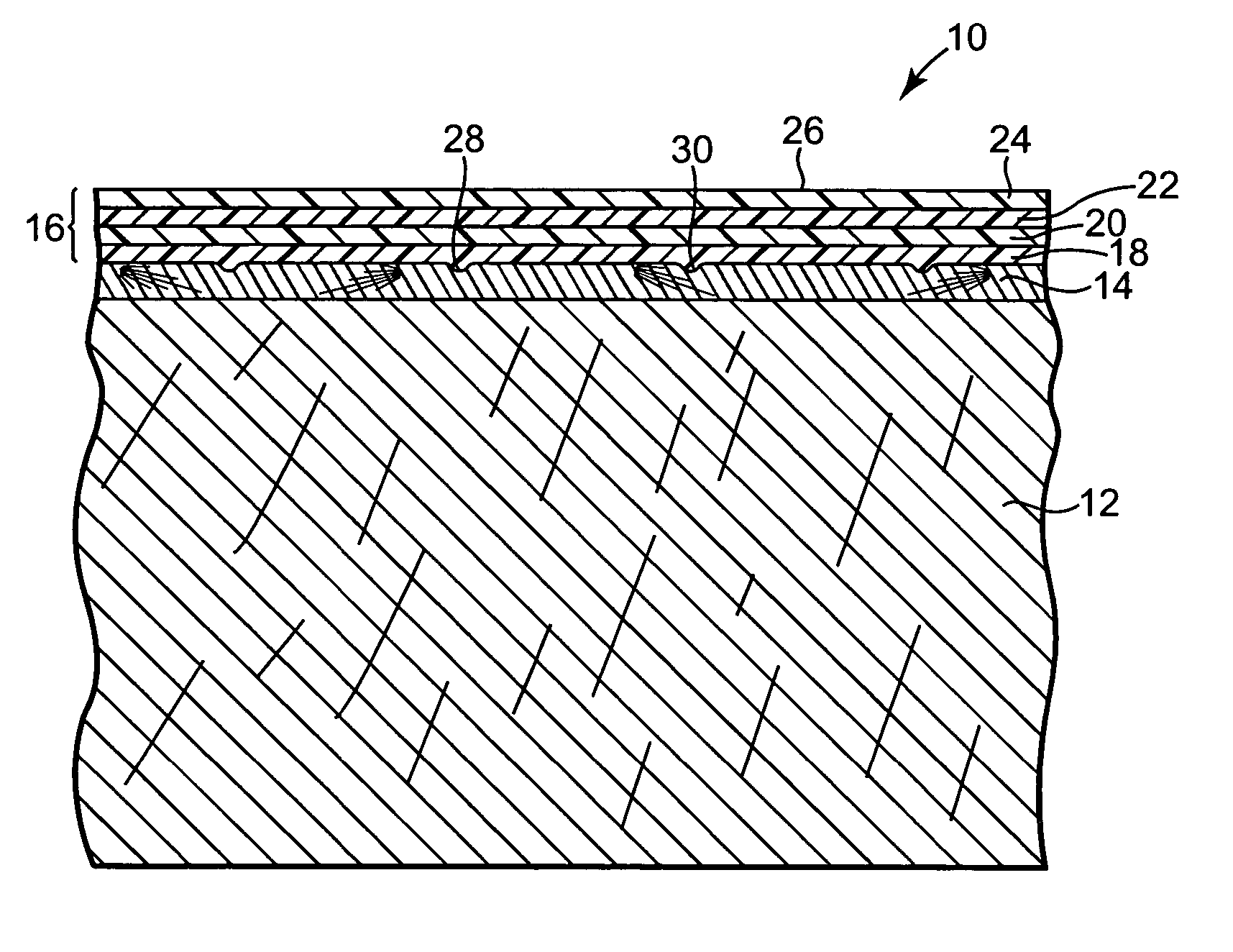Check-resistant veneer coating system
a veneer and check-resistant technology, applied in the field of check-resistant veneer coating system, can solve the problems of poor first coat or intercoat adhesion, poor finish, and inability to control the uv dosage, and achieve the effect of less sensitive and improved veneer check-resistant performan
- Summary
- Abstract
- Description
- Claims
- Application Information
AI Technical Summary
Benefits of technology
Problems solved by technology
Method used
Image
Examples
example 1
[0033] Selected wood planks were cut in half across their centers to form two pieces. The paired pieces were labeled as control or treated planks. The control planks were finished using a conventional four-layer system employing VALSPAR™ KEB0506 free radical UV curable stain, VALSPAR KTF0018 free radical UV curable filler, VALSPAR KPS0047 free radical UV curable sealer and VALSPAR 1735C52099 free radical UV curable topcoat, all available from Valspar Corp. The treated planks were finished using the cationic UV curable stain shown below in Table 1 and the cationic / free radical UV curable filler shown below in Table 2, followed by the control plank free radical UV curable sealer and free radical UV curable topcoat. At least 10 pairs of control and treated planks were coated for comparison.
TABLE 1Cationic UV Curable StainIngredientParts3,4-Epoxy cyclohexylmethyl-3,4-epoxy cyclohexyl carboxylate(1)79.13-Ethyl-3-hydroxymethyl oxetane(2)8.7Triarylsulfonium phosphate salt(3)7.2White epox...
example 2
[0038] Using the method of Example 1, planks were finished using the cationic UV curable stain shown below in Table 5, followed by a layer of the cationic / free radical UV curable filler shown below in Table 6, followed by a layer of the cationic / free radical UV curable filler shown below in Table 7, followed by the Example 1 free radical UV curable sealer and the Example 1 free radical UV curable topcoat. The veneer check results are set out below in Table 8.
TABLE 5Cationic UV Curable StainIngredientParts3,4-Epoxy cyclohexylmethyl-3,4-epoxy cyclohexyl carboxylate(1)77.13-Ethyl-3-hydroxymethyl oxetane(2)8.5Triarylsulfonium phosphate salt(3)6.9Yellow epoxy paste(4)4.3Red epoxy paste(5)2.2Carbon black epoxy paste(6)1.1
(1)CYRACURE UVR 6110 cycloaliphatic epoxide, available from Dow Chemical Co.
(2)CYRACURE UVR 6000 diluent, available from Dow Chemical Co.
(3)CYRACURE UVI 6992 photoinitiator, available from Dow Chemical Co.
(4)9Y185 epoxy, available from Penn Color, Inc.
(5)9R445 epoxy...
example 3
[0043] Using the method of Example 1, planks were finished using the cationic UV curable clearcoat shown below in Table 9, followed by the control plank free radical UV curable filler, control plank free radical UV curable sealer and control plank free radical UV curable topcoat. UV curing was performed using both continuous and pulsed UV. The veneer check results for the two curing techniques are set out below in Table 10.
TABLE 9Cationic UY Curable ClearcoatIngredientParts3,4-epoxy cyclohexylmethyl-3,4-epoxy cyclohexyl carboxylate(1)95Triarylsulfonium phosphate salt(2)5
(1)CYRACURE UVR 6110 cycloaliphatic epoxide, available from Dow Chemical Co.
(2)CYRACURE UVI 6992 photoinitiator, available from Dow Chemical Co.
[0044]
TABLE 10Hot Oven Veneer Check ResistanceRating, % of Treated PlanksEqual,Equal,MuchUV CureMuchNoSomeMoreMethodExcellentBetterBetterCheckCheckCheckPulsed UV06004000Continuous000206020UV
[0045] As shown in Table 10, the treated planks had at least equal and usually muc...
PUM
| Property | Measurement | Unit |
|---|---|---|
| Electrical resistance | aaaaa | aaaaa |
| Density | aaaaa | aaaaa |
| Adhesion strength | aaaaa | aaaaa |
Abstract
Description
Claims
Application Information
 Login to View More
Login to View More - R&D
- Intellectual Property
- Life Sciences
- Materials
- Tech Scout
- Unparalleled Data Quality
- Higher Quality Content
- 60% Fewer Hallucinations
Browse by: Latest US Patents, China's latest patents, Technical Efficacy Thesaurus, Application Domain, Technology Topic, Popular Technical Reports.
© 2025 PatSnap. All rights reserved.Legal|Privacy policy|Modern Slavery Act Transparency Statement|Sitemap|About US| Contact US: help@patsnap.com


